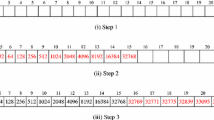Abstract
An addition sequence problem is given a set of numbers X = {n 1, n 2, . . . , n m }, what is the minimal number of additions needed to compute all m numbers starting from 1? This problem is NP-complete. In this paper, we present a branch and bound algorithm to generate an addition sequence with a minimal number of elements for a set X by using a new strategy. Then we improve the generation by generalizing some results on addition chains (m = 1) to addition sequences and finding what we will call a presumed upper bound for each n j , 1 ≤ j ≤ m, in the search tree.
Similar content being viewed by others
References
Bahig H (2006) Improved generation of minimal addition chains. Computing 78: 161–172
Bahig H, Bahig H (2006) Speeding up evaluation of powers and monomials. In: Proceedings of the 2006 international conference on foundations of computer science, June 26–29, pp 149–153 (an extended abstract)
Bahig H, Nakamula K (2002) Some properties of nonstar steps in addition chains and new cases where the Scholz conjecture is true. J Algorithms 42: 304–316
Bergeron F, Berstel J, Brlek S (1994) Efficient computation of addition chains. J Theor Nombres Bord 6: 21–38
Bergeron F, Berstel J, Brlek S, Duboc C (1989) Addition chains using continued fractions. J Algorithms 10: 403–412
Bleichenbacher D (1996) Efficiency and security of cryptosystems based on number theory, chap 4. A Docotor Thesis, Swiss Federal Institue of Technology Zurich, Zurich
Chen Y, Chang C, Yang W (1994) Some properties of vectorial addition chains. Int J Comput Math 54: 185–196
Chin YH, Tsai YH (1985) Algorithms for finding the shortest addition chain. In: Proceedings of national computer symposium, Kaoshiung, Taiwan, December 20–22, pp 1398–1414
de Rooij P (1995) Efficient exponentiation using precomputation and vector addition chains. In: Advances in cryptology—EUROCRYPT ’94 (Perugia), lecture notes in computer science, vol 950, pp 389–399
Downey P, Leong B, Sethi R (1981) Computing sequences with addition chains. SIAM J Comput 10(3): 638–646
Flammenkamp A (1999) Integers with a small number of minimal addition chains. Discrete Math 205: 221–227
Gordon DM (1998) A survey of fast exponentiation methods. J Algorithms 122: 129–146
Knuth DE (1997) The art of computer programming: seminumerical algorithms, vol 2, 3rd edn. Addison-Wesley, Reading, pp 461–485
Laih C, Yen S (1992) Secure addition sequence and its applications on the server-aided secret computation protocols. In: Advances in cryptology-AUSCRYPT’92, lecture notes in computer science, vol 718, pp 219–229
Laih C, Yen S, Harn L (1991) Two efficient server-aided secret computation protocols based on the addition sequence. In: Advances in cryptology-ASIACRYPT’91, pp 450–459
Olives J (1981) On vectorial addition chains. J Algorithms 2: 13–21
Rivest R, Shamir A, Adleman L (1978) A method for obtaining digital signatures and public-key cryptosystems. Commun ACM 21(2): 120–126
Schönhage A (1975) A lower bound for the length of addition chains. Theor Comput Sci 1: 1–12
Thurber EG (1973) The Scholz-Brauer problem on addition chains. Pac J Math 49: 229–242
Thurber EG (1999) Efficient generation of minimal length addition chains. SIAM J Comput 28: 1247–1263
Yen S, Laih C (1992) The fast cascade exponentiation algorithm and its applications on cryptography. In: Proceeding of Auscrypt’92, Australia, lecture notes in computer science, vol 718, pp 447–456
Author information
Authors and Affiliations
Corresponding author
Additional information
Communicated by F. Rendl.
Rights and permissions
About this article
Cite this article
Bahig, H.M., Bahig, H.M. A new strategy for generating shortest addition sequences. Computing 91, 285–306 (2011). https://doi.org/10.1007/s00607-010-0119-7
Received:
Accepted:
Published:
Issue Date:
DOI: https://doi.org/10.1007/s00607-010-0119-7
Keywords
- Addition chains
- Addition sequences
- Branch and bound algorithm
- High-performance arithmetic
- Monomials evaluation
- Vectorial addition chains




